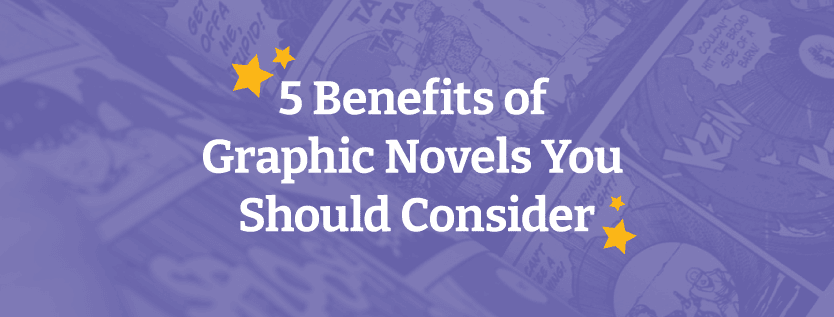
With summer officially here, asking a child to read a book might be like pulling teeth. However, it doesn’t have to be impossible. Graphic novels are the secret to promoting literacy and turning children into avid readers. While it may be easy to dismiss them as not “real reading”, this couldn’t be further from the truth. In fact, the benefits of graphic novels may just change your mind.
Here are 5 reasons why you should have your child read graphic novels this summer.
Visual literacy is a skill that’s becoming critical for 21st-century learners who are exposed to and must interpret more diverse forms of media. Typically, graphic novels are more inventive and sometimes chaotic compared to traditional linear reading. Yet the added use of thought balloons, panels, gutters, and other comic designs allow readers to use their imagination and practice visual literacy.
In addition, graphic novels include a diverse range of vocabulary words. Presenting a word along with a visual of its implied meaning helps children to better retain definitions. This can improve the mental lexicon of the reader and expand on their vocabulary.
Graphics often encourage and reward non-linear thinking. This is because graphic novels often involve unconventional storytelling methods. This fun and unique approach captures the reader’s imagination, inspiring them to think of their own plots and character arcs for the story, or even create a story of their own!
Graphic novels can also enhance other subject areas such as history or biographies to greatly improve the understanding of a difficult topic. One great example is the story of Maus which communicates the tough reality of the history of the Holocaust in an engaging and meaningful way.
The most important aspect of graphic novels isn’t the literary value, but instead, the social & emotional learning (SEL). With a wide selection to choose from, graphic novels can speak to an array of readers in a meaningful way, which paves the way to open communication. Graphic novels are also much more accessible and adapt to a variety of reading levels. They can also provide immersive perspectives on different situations to help readers foster empathy for themselves and others.
Children who read graphic novels benefit from inference-making skills, improved memory, sequential order, and concise language. It also forces reluctant readers to slow down and fully digest the story. Graphic novels can do much of the heavy lifting for students that traditional prose can’t, and this can improve the overall comprehension of a story, in turn improving test scores and grades.
Moreover, they provide a gateway into social groups and networks which will, in turn, boost a reader’s confidence and self-esteem.
Graphic novels are a great way to promote reading literacy and combat learning disabilities. Instead of reading through blocks of text, students can scan designs with smaller texts. This can help students who struggle with learning disabilities such as dyslexia and find it frustrating to make it through a single page of text. Students can instead feel a boost of confidence through comprehension of the plot and more advanced literary devices that are key to understanding the story.
Someone struggling with a learning disability may get stuck on the vocabulary or storyline, but graphic novels help by offering contextual cues to help decipher meaning. This allows those who are struggling to understand the novel better and also contributes to literary discussions in the classroom.
Graphic novels are a great way to help children who aren’t passionate about reading. When kids think of comic books they often think of superheroes, and the powerful influence of graphic novels is that they can sneak important literary elements under the guise of a fun, action-packed comic.
Classic literature can easily transform into graphic novels and create a unique re-telling of classic tales. Imagine Atticus Finch representing Tom Robinson in vibrant color. Or feeling the weight of Hamlet’s infamous “To be, or not to be” soliloquy with designs that show students his mental instability as they read.
The adage goes “show don’t tell”, and pairing graphic novels with classic literature is a great way to get readers excited about a literary theme. Start with a graphic novel to introduce the concept, then go into more detail with a literary classic to prove the worth behind the stories. Providing common threads throughout the two stories makes them richer in context and enhances the storytelling, which in turn boosts reading comprehension and motivation.
Here at Renton Prep, we strive to make education not only practical but also fun for our students. Students learn better when they’re motivated and excited. This is why we are constantly improving our curriculum and school environment to create quality instruction that allows students to bloom into powerful leaders of society.
To learn more about our teaching methods and curriculum, contact us or apply for this upcoming school year.